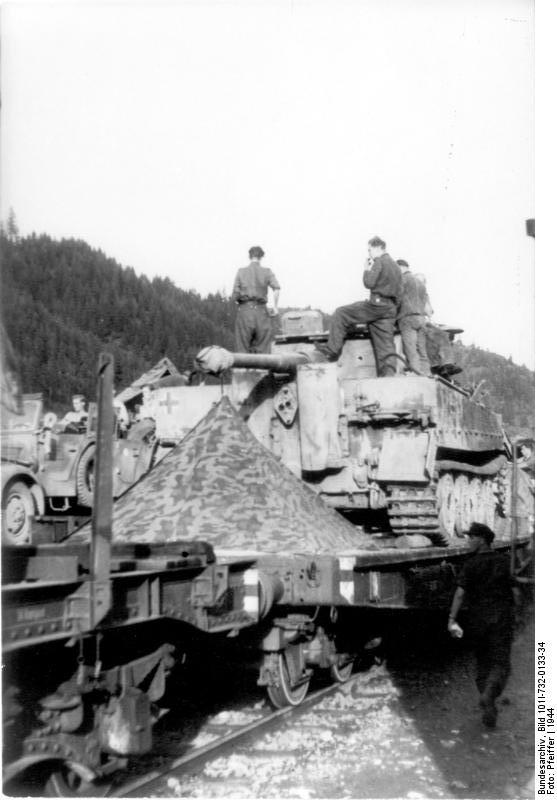
| Caption | German Tiger I heavy tank of the German 'Großdeutschland' Division being transported by railroad, Romania, 1944 ww2dbase | ||||
| Photographer | Pfeiffer | ||||
| Source | ww2dbaseGerman Federal Archives | ||||
| Identification Code | Bild 101I-732-0133-34 | ||||
| More on... |
| ||||
| Photo Size | 557 x 800 pixels | ||||
| Added By | C. Peter Chen | ||||
| Licensing | Creative Commons Attribution ShareAlike 3.0 Germany License (CC BY-SA 3.0 DE).
See Bild 101I-732-0133-34 on Wikimedia Commons According to the German Federal Archive (Bundesarchiv), as of 21 Jul 2010, photographs can be reproduced with if these preconditions are met: - add the signature of the pictures and - of name of the originator, i.e. the photographer. ... You also can use fotos from the Federal Archives for free on Wikimedia Commons http://commons.wikimedia.org/wiki/Commons:Bundesarchiv Please contact us regarding any inaccuracies with the above information. Thank you. |
Did you enjoy this photograph or find this photograph helpful? If so, please consider supporting us on Patreon. Even $1 per month will go a long way! Thank you. Share this photograph with your friends: Stay updated with WW2DB: |
Visitor Submitted Comments
2.  Bill says:
Bill says:
10 Feb 2011 06:00:29 PM
ANOTHER TIGER TAKES THE MIDNIGHT TRAIN TO:
Hurry up and wait, same in any army.
First photo shows the Bergepanzer-Tiger on
the first flatcar walking down the line, we see another Tiger on the flatcar behind it.
Look close, and you can see this Tiger has its outer roadwheels removed for transport.
The soft skinned vehicle next to the Tiger is
the Steyer 1500A/01 4x4 light truck.
10 Feb 2011 06:00:29 PM
ANOTHER TIGER TAKES THE MIDNIGHT TRAIN TO:
Hurry up and wait, same in any army.
First photo shows the Bergepanzer-Tiger on
the first flatcar walking down the line, we see another Tiger on the flatcar behind it.
Look close, and you can see this Tiger has its outer roadwheels removed for transport.
The soft skinned vehicle next to the Tiger is
the Steyer 1500A/01 4x4 light truck.
All visitor submitted comments are opinions of those making the submissions and do not reflect views of WW2DB.
Search WW2DB
News
- » WW2DB's 20th Anniversary (29 Dec 2024)
- » Wreck of USS Edsall Found (14 Nov 2024)
- » Autumn 2024 Fundraiser (7 Nov 2024)
- » Nobel Peace Prize for the Atomic Bomb Survivors Organization (11 Oct 2024)
- » See all news
Random Photograph
Current Site Statistics
- » 1,150 biographies
- » 337 events
- » 44,024 timeline entries
- » 1,242 ships
- » 350 aircraft models
- » 207 vehicle models
- » 375 weapon models
- » 123 historical documents
- » 260 facilities
- » 470 book reviews
- » 28,588 photos
- » 432 maps
Famous WW2 Quote
"Since peace is now beyond hope, we can but fight to the end."Chiang Kaishek, 31 Jul 1937
Support Us
Please consider supporting us on Patreon. Even $1 a month will go a long way. Thank you!
Or, please support us by purchasing some WW2DB merchandise at TeeSpring, Thank you!
14 Mar 2010 05:37:03 PM
One night I watched a documentary on Railroads on the History Channel and it mentioned the German invasion of Russia.
All of Russia's railroads had wider locomotives axles, rail car axles and tracks.
Either the Germans had to change the width of the rails, which they did for thousands of miles or transfer their cargoes to captured Russian trains.
The documentary showed the Germans moving one side of the rails over to their own standard width.
They used a gages to keep the width correct and moved the rail mile after mile.
The number 5,000 miles seems to stick with me, and after the war all the rails had to be reset to the Russian width again.
At the time I worked with a few Railroad enthusiasts. They knew about the Russian and German issues during the war and relocating the rails.